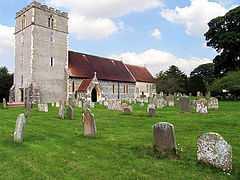Chieveley
| Chieveley | |
 St Mary's Church |
|
 Chieveley |
|
| Area | 20.86 km2 (8.05 sq mi) |
|---|---|
| Population | 2,890 (2011 census)[1] |
| – density | 139/km2 (360/sq mi) |
| OS grid reference | SU474738 |
| Civil parish | Chieveley |
| Unitary authority | West Berkshire |
| Ceremonial county | Berkshire |
| Region | South East |
| Country | England |
| Sovereign state | United Kingdom |
| Post town | Newbury |
| Postcode district | RG20 |
| Dialling code | 01635 |
| Police | Thames Valley |
| Fire | Royal Berkshire |
| Ambulance | South Central |
| EU Parliament | South East England |
| UK Parliament | Newbury |
| Website | MyChieveley.co.uk |
Coordinates: 51°27′40″N 1°19′08″W / 51.461°N 1.319°W
Chieveley /ˈtʃiːvli/ is a village and large civil parish centred 3.5 miles (5.6 km) north of Newbury in Berkshire, close to the M4 motorway and A34 road. Chieveley services are within the parish - restaurants between junctions on the M4.
Character

A map of 1877 stated the area at the time to be 5,328 acres (21.56 km2). Chieveley Service Station serves Junction 13 of the M4 motorway.
The landscape is of gently rolling chalk hills. The land is predominantly arable with some dairy, sheep and pigs. There is a healthy quantity of woodland and abundant wildlife. There is a network of green lanes and footpaths that afford good walking.
The civil parish consists of the villages of Chieveley and Curridge and the hamlets of Downend, Oare and Snelsmore Common. The original parish also included Leckhampstead and Winterbourne. The structure has been much affected by roads. The M4 passes east-west through the middle of the parish and has done much to cut Curridge and Oare from Chieveley. This was opened in 1971. The A34 running north-south quarters the parish. Its path has moved several times, the most recent development being a change to Junction 13 that opened in Autumn 2004.
The landscape is dominated by farming. There are currently three working farms in the parish. Other industries include a garden centre, land-fill site, hotels, baker and many small businesses.
Transport
From 18 February 2013, Chieveley is served by bus services 6, 6A and 107 from Newbury.[2]
History
There is ancient civilisation nearby that indicates early settlement. The parish boasts a fine Iron Age hill fort in Snelsmore, called Bussock Camp. This is in private grounds but is visible in May when they are opened to the public to view the fine display of bluebells.
The name Chieveley is said to be derived from 'Field of Chives'. The WI's 'Berkshire Book' assures the reader that chives were noted in the area as far back as 951. This is the same year that King Edred gave the village to his bailiff, Wulf.
The Domesday Book of 1086 says this of Chieveley (source: The National Archives):
- In Rowbury Hundred
- The abbey itself holds Chieveley. It has always held it. TRE (in the reign of Edward the Confessor) it was assessed at 27 hides; now at 7½ hides with land for 20 ploughs. In demesne are 3 ploughs; and 28 villains and 10 bordars with 18 ploughs. There are 3 slaves, and 4 acres (16,000 m2) of meadow, [and] woodland for 60 pigs. Of this land William holds of the abbot 5 hides, and Godfrey 1½ hides, and there is 1 plough, with 3 villains and 2 bordars having 1 plough, and 3 acres (12,000 m2) of meadow. The whole, TRE and afterwards, was worth 12l; now the abbot's portion [is worth] 10l; [that] of his men 50s.
This text is a structured shorthand tax assessment and identifies 39 men, many of which would have had their own households, and three serfs, a form of slavery done away with early in the feudal system, generally in the era of Magna Carta.
In August 1207, King John seems to have had a good few days' hunting in West Berkshire. He is reported in Curridge on the 3rd and Chieveley on the 5th.
The first vicar of Chieveley was Elias, appointed in 1154. It is likely that there was a Saxon church before it was replaced by the Normans and later the Victorians. Chieveley parish registers start on 10 April 1560. There are still several families in the area who were recorded in those annals.
Chieveley once had its own maypole, on the site now occupied by Maypole Cottage (on the corner of the High Street and Church Lane).
Demography
| Output area | Homes owned outright | Owned with a loan | Socially rented | Privately rented | Other | km² roads | km² water | km² domestic gardens | Usual residents | km² |
|---|---|---|---|---|---|---|---|---|---|---|
| Civil parish | 341 | 326 | 53 | 189 | 21 | 0.019 | 0.783 | 2890 | 20.86 |
Notable residents
- Robert Goff, Baron Goff of Chieveley, a retired Senior Appeal Judge
- The mother of Lord Chief Justice Holt.
References
- Much of the text for this page was originally taken, with permission, from MyChieveley.co.uk.
External links
![]() Media related to Chieveley at Wikimedia Commons
Media related to Chieveley at Wikimedia Commons